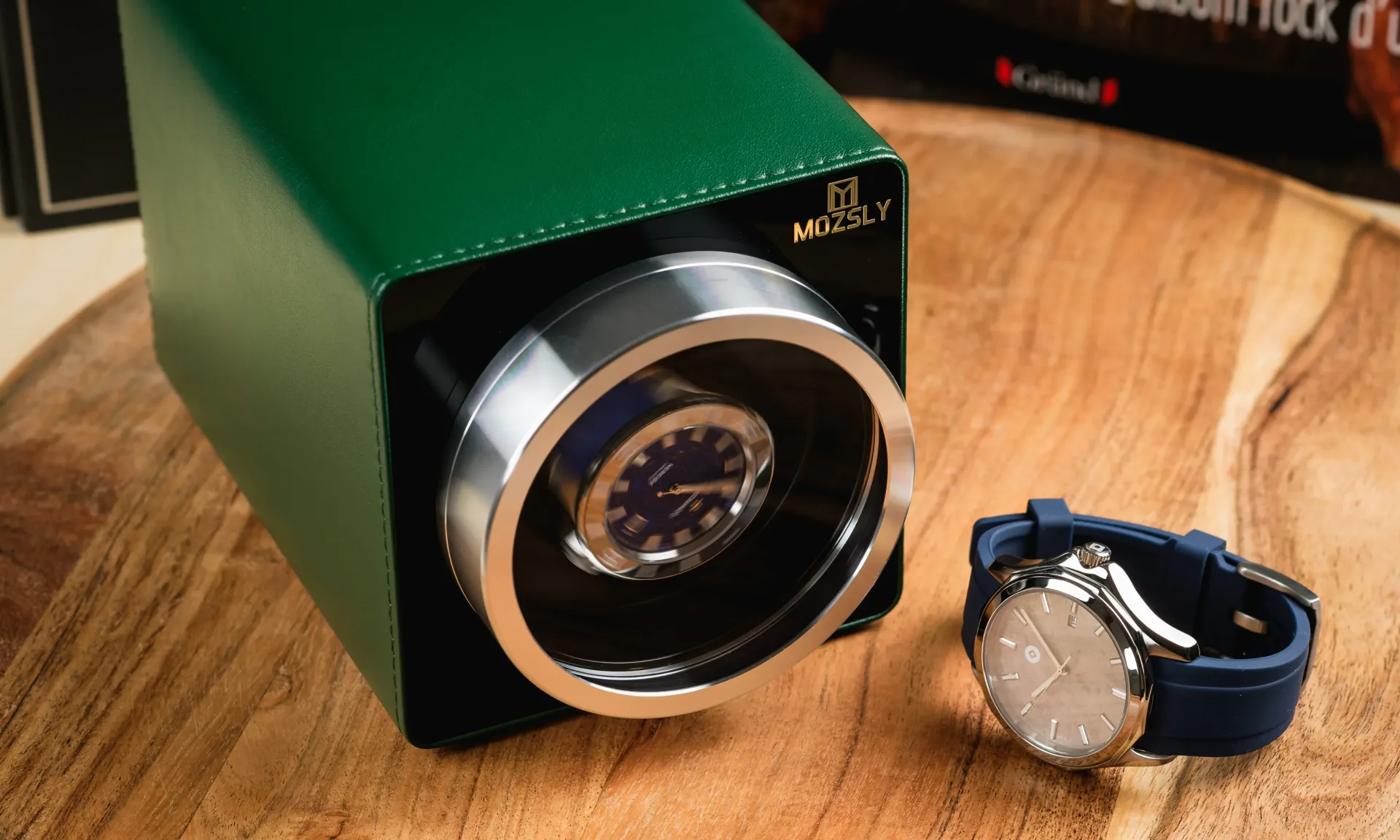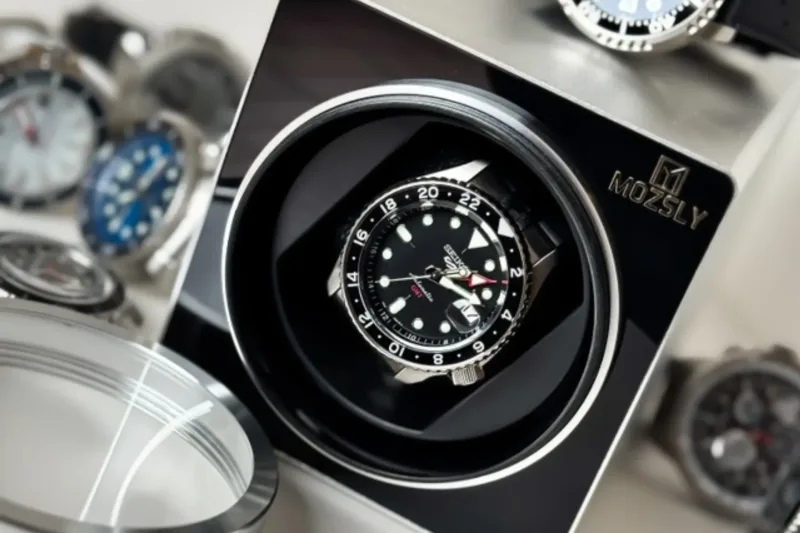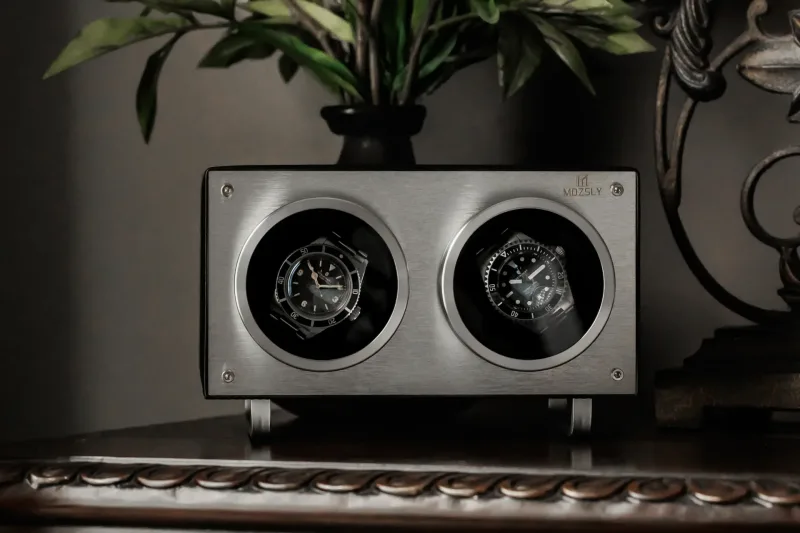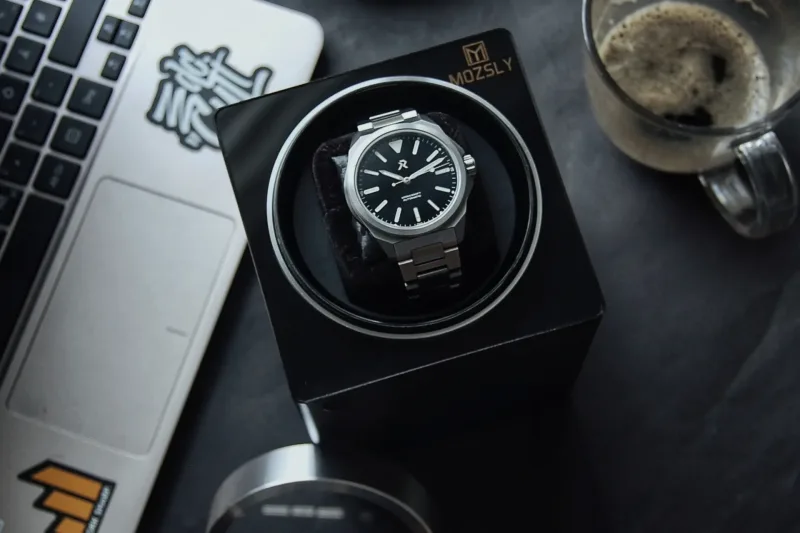Share This Post
The watch’s limited lifespan frustrates many owners—especially those who invest a fortune.
I’ve personally experienced this: My Tudor Black Bay watch spent more time in a drawer than on my wrist. My neighbor also used an automatic winder to wind her watch, and her service report was flawless, while mine cost hundreds of dollars. That’s when I became convinced that an automatic winder could extend the lifespan of an automatic watch.
After consulting several watchmakers, I learned that a watch winder can extend the lifespan of an automatic watch by reducing wear on its movement and helping you avoid accidental damage. Now, I’m happy to share this knowledge with fellow watch enthusiasts.
Why Automatic Watch Winders Extend Lifespan
Inside an Automatic Watch: Aging of Movement Components
An automatic movement is a tiny machine, and three components are crucial to its lifespan:
– The rotor—a weighted semi-circular disk that rotates with wrist movement. – Mainspring—a wound metal band that stores energy.
– Escapement and bearings—the heart of the watch, along with the tiny jeweled pivots that support it.
These components rely on lubrication. When lubrication is evenly distributed, friction is low; when lubrication accumulates, metal-on-metal friction occurs, accelerating wear.
Leaving a watch unused for days lets lubrication recede from high-load areas. Restarting a watch after a layoff stresses components, just like starting a cold engine—the first revolutions face extra stress.
Continuous Operation vs. Cold Start
Imagine two cars:
- A highway cruiser: Driving at a steady pace, the oil is warm, and the parts operate smoothly.
- A cold-start commuter car: With frequent starts and stops, the oil thickens each morning, and the engine parts rub against each other until they heat up.
Automatic watches face the same situation. A high-quality winding mechanism drives the rotor in a slow, controlled cycle, similar to a slow highway cruise. This steady motion keeps the oil in the correct position, preventing pressure spikes with each restart.
Research confirms this. A 2023 American Watchmakers’ Guild (AWCI) bulletin noted that movements stored in programmable winding mechanisms “maintain the viscosity of synthetic oil better than movements left idle,” typically delaying the need for a full service by one to two years.
Watchmaker’s Summary in the Workshop
Watchmakers in the workshop have examined thousands of watches and made three common observations:
- Fewer dry bearings—Watches equipped with a winding mechanism have cleaner, more lubricated pivots (Rolex-trained technician Laura Méndez).
- Fewer rotor changes—Continuous, gentle movement produces less shock than the repetitive rotations caused by forceful winding (Eric Chen, CW21).
- More stable long-term timekeeping—A never-dry escapement avoids sudden drops in amplitude (independent watch expert Marco Salvi).
These data, derived from field notes recorded on service tickets and posted to the brand’s repair portal, largely suppor
Is it necessary to buy a watch winder?
While watch winders extend life, watch winders are not suitable for everyone, but three user groups experienced measurable benefits:
Multiple-Watch Owners
If you rotate three or more automatics, some pieces will sit idle for days or weeks. Idle time lets oil settle and seals dry. A winder keeps each movement exercising gently, so:
- Lubricant films stay spread over pivots.
- Rotor bearings avoid sudden “first-spin” torque spikes.
- You use screw-down crowns less, which lengthens gasket life (IWC service data show that roughly 25% of crown replacements stem from over-use).
Complicated Calendars
Perpetual calendars, moon-phases, and GMT modules hate resets. Every time you pull the crown:
- You disrupt the keyless works, adding wear.
- You risk stripping tiny gears or cross-threading the crown tube.
A winder reduces crown pulls by 90 % or more. Patek Philippe’s training guide actually recommends a programmable winder to owners who wear complicated models less than twice a week.
Vintage or Delicate Pieces
Older alloys and early synthetic oils are less forgiving:
- Vintage mainsprings can “set” (lose elasticity) if left fully unwound.
- Early escapement pivots lack modern shock protection; gentle, predictable motion is safer than abrupt hand-winds.
Most restorers set pre-1980 watches for low-RPM rotation with long rest intervals—a setting only a good winder provides.
The right tools: Functions that protect, not harm
If you have made up your mind to purchase a watch winder, remember that not every watch winder is created equal. Here are the core engineering points that a safe watch winder must cover, along with the reasons for each important factor. You can think of it as a simple strategy guide.
Adjustable number of laps per day (TPD 650 – 950)
Why: Every movement has a sweet spot. If the number of revolutions is too few, the watch will stall and accumulate oil; if it is too many, the mainspring will be at maximum tension, and the walls of the barrel will wear out faster.
Directional Control (CW/CCW/Bidirectional)
Reason: Branded clutches vary. Rolex winds both ways, Omega prefers clockwise, and Seiko usually prefers counterclockwise. Matching directions means fewer wasted cycles and less clutch wear.
Programmable break time (minimum 15 – 30 minutes)
Cause: Oil is redistributed, and the mainspring is slack. Continuous rotation keeps the torque at 100% – exactly what watchmakers are trying to avoid.
Low noise, low vibration Japanese motor
Reason: Mabuchi-type motors run smoothly, protecting the rotor bearings from microshocks and avoiding stray magnetic fields that can cause accuracy to degrade by several minutes per day.
Safe, form-fitting cushioning
Cause: A wobbly pillow can shake the housing, scratch the lugs, and increase lateral loads on the rotor shaft. Sturdy flocked inserts keep everything centered and secure.
Electromagnetic shielding or non-magnetic housing (extra but useful)
Cause: Even small DC motors produce magnetic fields. Basic shielding (aluminum or highly permeable alloys) can reduce this and preserve the authenticity of the hairspring.
Backup Power Options (AC + AA Batteries or USB Power Bank) (Required)
Why: A brief power outage should not disrupt careful programming, especially if your watch is a perpetual calendar hidden in a safe.
Models like the Mozsly Watch Winder tick all the required boxes (1 – 5) and even come with USB power for travel (point 7). Stick to this list and you’ll protect rather than punish your favorite automatic transmission.
Conclusion
A good watch winder can play a significant role in maintaining the health and longevity of your automatic watch. By keeping it lubricated and operating smoothly, a quality winder can extend maintenance intervals and protect every tick—supporting the idea that a watch winder may help your automatic watch live longer.
Choosing a high-quality watch winder will help your watch shine longer on your wrist, rather than being stored away on a shelf.
Related Post's
Featured Video
Provide an email subscription feature for users to sign up for updates.
Follow the world of watches and cigars for exclusive content!
By subscribing to our newsletter, you will be the first to receive notifications of our latest articles, popular posts and special events.








